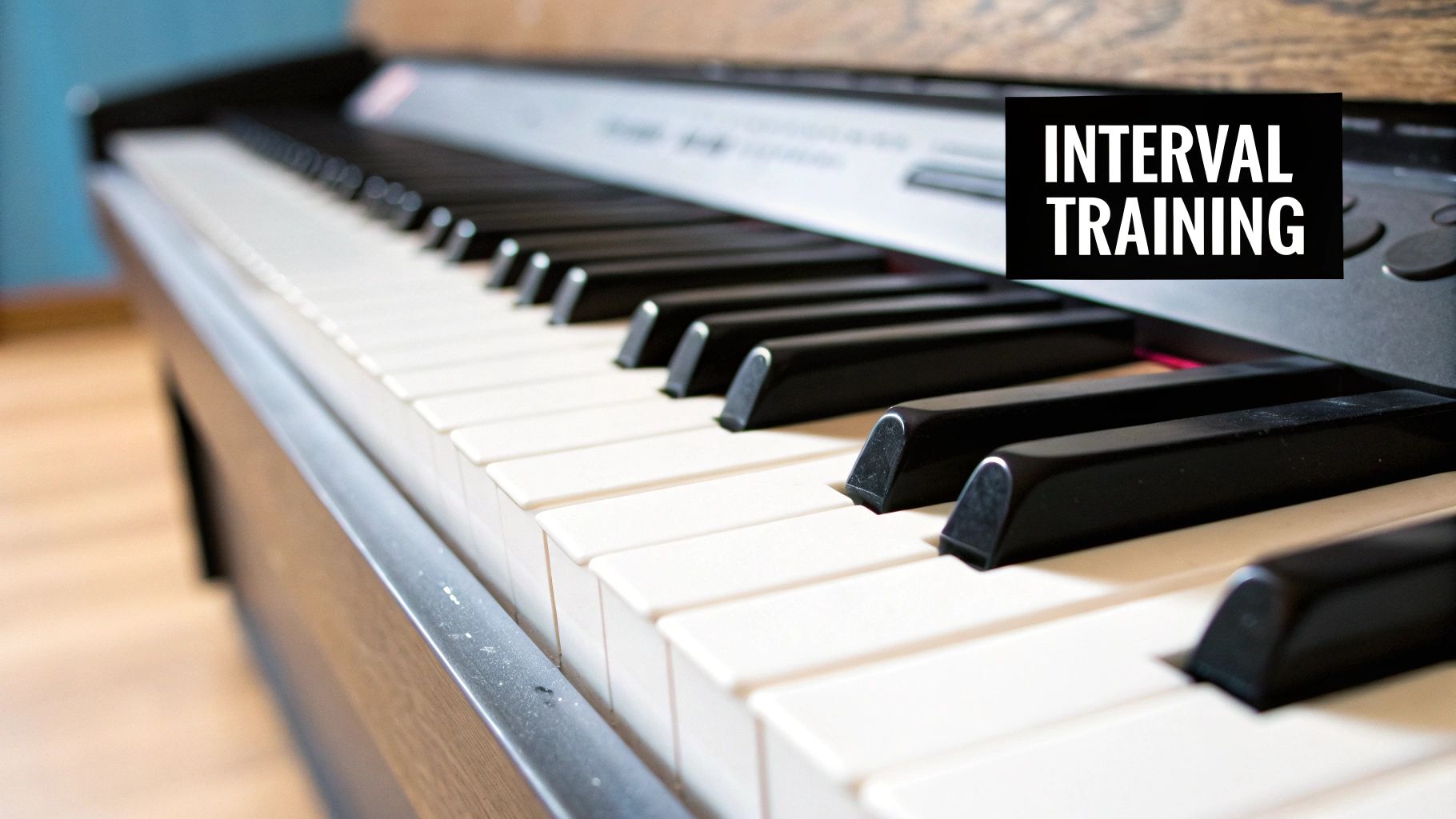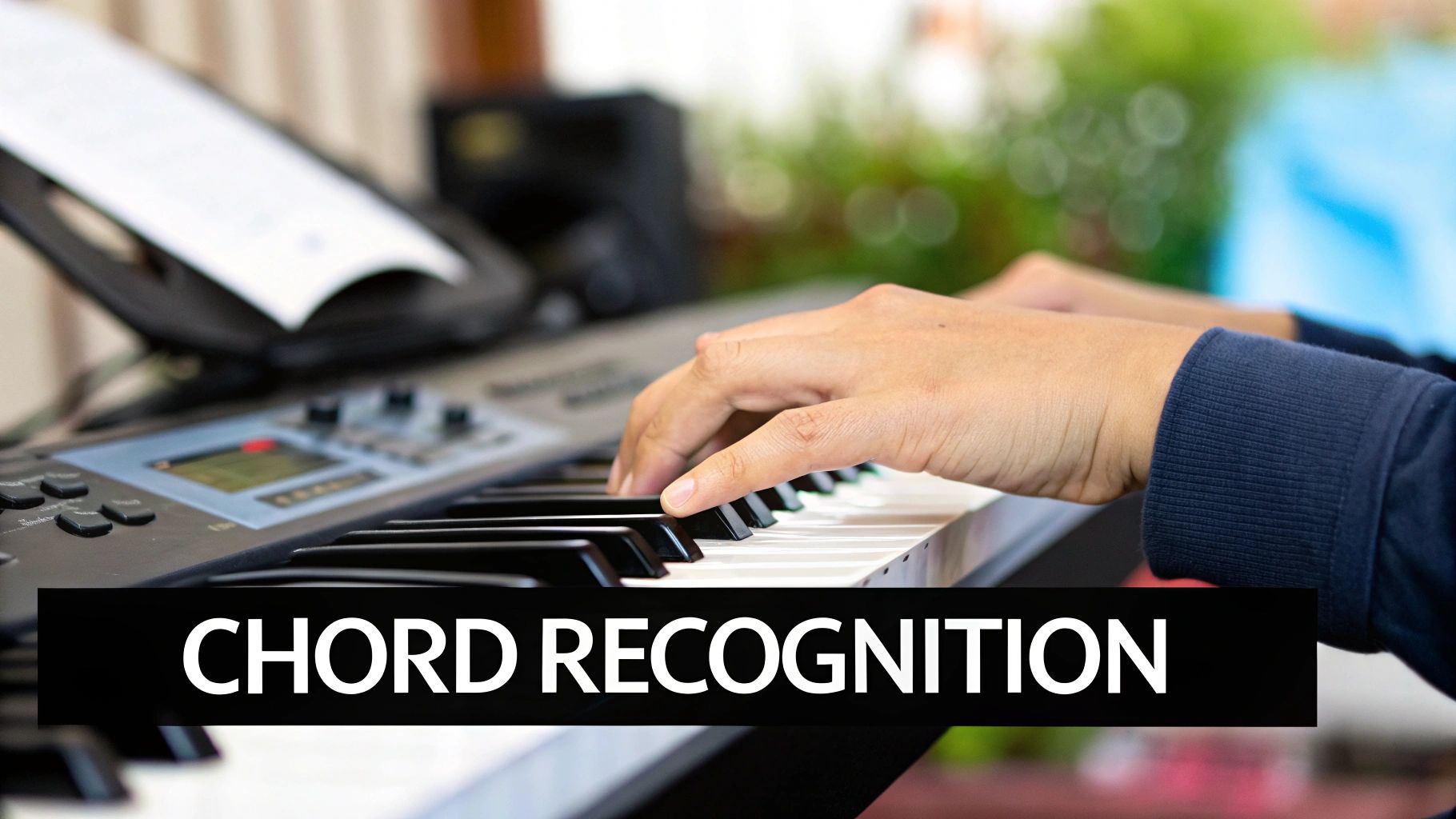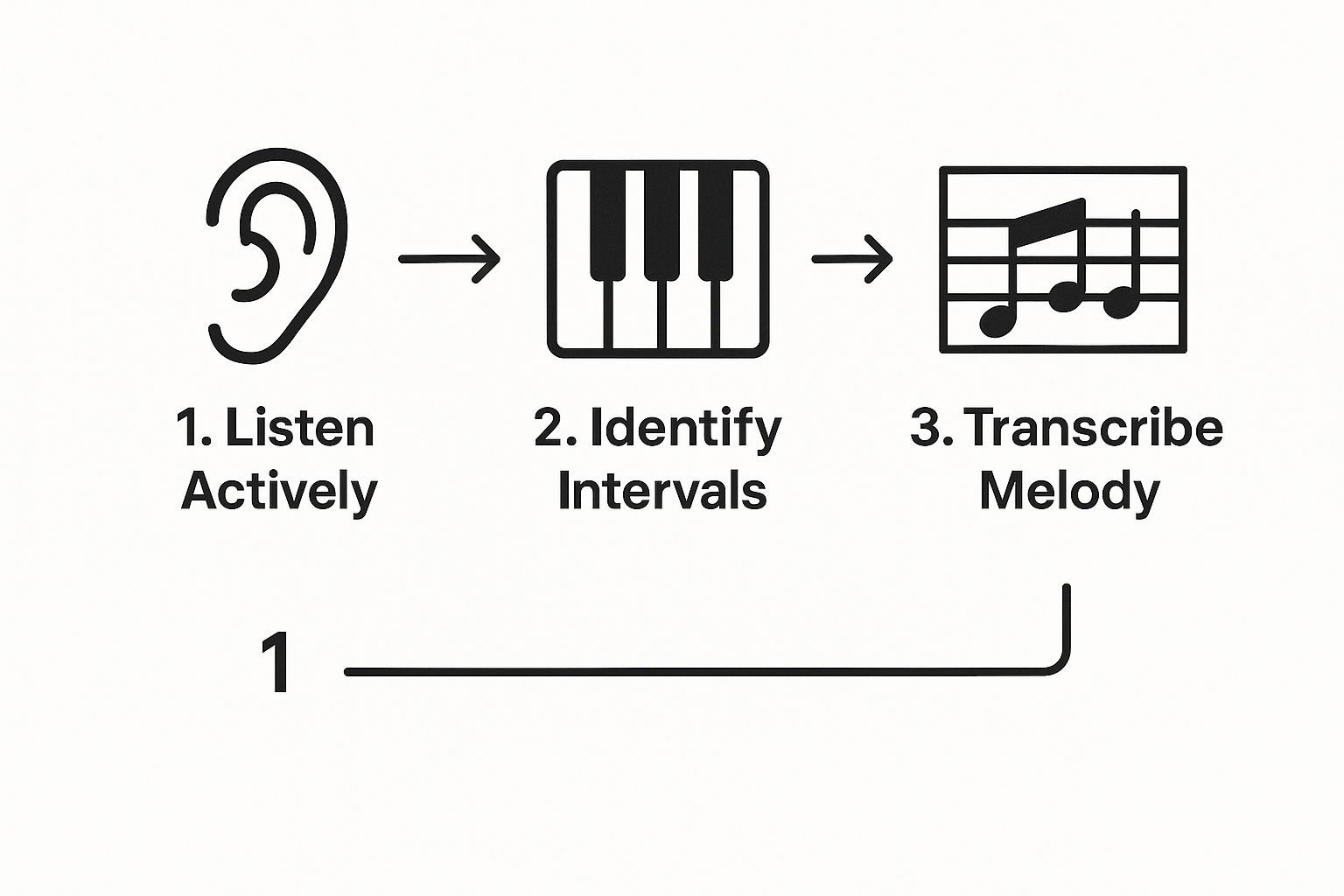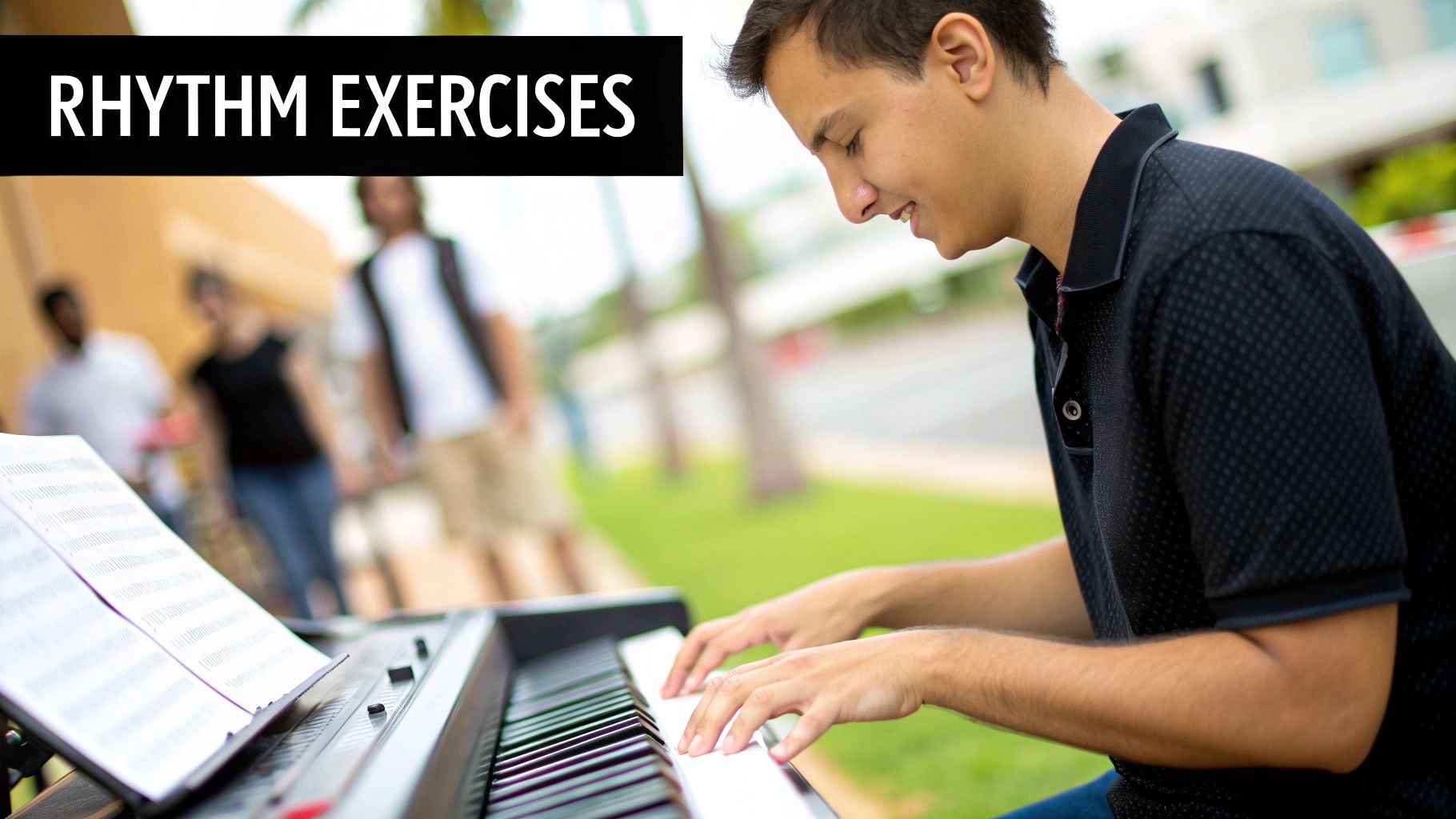A Practical Guide to Ear Training for Piano
Unlock your musical potential with this guide to ear training for piano. Learn practical exercises for intervals, chords, and playing by ear.
Posted by
Joe BrewerRelated reading
Music Intervals Training: Boost Your Ear & Skills Today
Master music intervals training with expert exercises and tips. Enhance your ear training skills quickly and effectively. Start improving now!
Understanding the Circle of Fifths: A Musician's Essential Guide
Master understanding circle of fifths with this comprehensive guide. Learn to read, build chords, and enhance your music skills today!
How to Learn Music by Ear and Master Songs
Discover how to learn music by ear with actionable techniques and real-world exercises. Transform your musical skills and start playing any song you hear.
A Practical Guide to Ear Training for Piano
Ear training for the piano is all about forging a deep connection between the sounds you hear and the keys under your fingers. It’s the skill that lets you play what's in your head, or what you hear on the radio, without having to first hunt down the sheet music. This is what it means to move beyond just reading notes and start truly understanding the language of music. It's your ticket to real musical freedom.
Why Ear Training Is Your Piano Superpower
Let’s be real for a moment. A lot of pianists see ear training as a boring, mandatory exercise from their formal lessons—something to get through, not enjoy. But that view completely misses the point. This isn't about acing a test; it's about building an intuitive bridge between your mind, your ear, and your fingers.
Think about hearing a melody and instantly knowing how to find it on the keyboard. That’s not a magical gift. It’s a skill you can build, piece by piece.
Once you have it, your entire relationship with the piano changes. You stop being someone who just follows instructions (the sheet music) and become a musician who genuinely speaks the language of sound. I can tell you from my own journey, the shift is incredible. Improvising stops feeling like a random walk through a scale and starts feeling like you're actually playing the music you hear in your head.
The Practical Benefits of a Trained Ear
Developing your ear isn't some abstract, far-off goal. It delivers concrete results that you'll notice in your playing every single day. The time you put into it pays you back over and over again.
You'll quickly see improvements in a few key areas:
- Learn Songs Faster: You can start picking out pop songs, film scores, or your favorite tunes by ear, without waiting for a tutorial or finding the score online.
- Improvise with Confidence: Your solos will sound more purposeful and melodic because you’re playing the notes you intend to hear, not just fumbling for something that fits.
- Boost Your Musical Memory: When you internalize the sound of a piece, not just the finger movements, you memorize it more deeply and securely.
- Correct Mistakes Instantly: Hit a wrong note? You'll know it right away and, more importantly, you'll know why it's wrong and what the right note should be.
This evolution from "reading" music to "speaking" it is what separates a proficient technician from a true musician. It’s the difference between reciting a script and having a fluent conversation.
A quick look at how pianists are taught professionally shows just how vital this skill is. The global market for piano training centers, which almost always integrate aural skills into their programs, was valued at $6,613.8 million in 2025. It’s expected to grow to $10,782.4 million by 2033. That’s a huge investment, and it highlights a core belief in the industry: a good ear is fundamental to piano mastery. You can find out more about the growth of comprehensive piano education and its market trends.
Here’s a quick summary of what you stand to gain by making ear training a priority in your practice.
Core Benefits of Ear Training for Pianists
| Skill Acquired | Practical Application on Piano |
|---|---|
| Interval Recognition | Instantly identify the distance between two notes, making it easier to build chords and harmonize melodies. |
| Chord Quality Recognition | Hear the difference between major, minor, and diminished chords, allowing you to play by ear with richer harmony. |
| Melodic Dictation | Transcribe melodies you hear directly onto the piano, perfect for learning new songs on the fly. |
| Rhythmic Perception | Internalize complex rhythms, improving your timing, groove, and ability to play with other musicians. |
Ultimately, a well-trained ear gives you the confidence to sit down at any piano and simply play, trusting your instincts and your understanding of sound.
Building Your Foundation with Interval Recognition
This is where your ear training journey really begins to take shape at the piano. Forget dry, abstract theory for a moment. We're going to build your ability to recognize intervals, one by one, until they feel as familiar as an old friend's voice. The secret? Connecting these sounds to melodies already hardwired into your brain.
An interval is just the distance between any two notes. Instead of trying to memorize their theoretical names from a textbook, a far more effective method is to associate each one with a famous song. This turns a potentially tedious chore into a fun game of "name that tune."
For example, most of us can instantly hum "Twinkle, Twinkle, Little Star." Those first two notes form a perfect fifth. That iconic, soaring leap at the beginning of "Somewhere Over the Rainbow"? That's a perfect octave.
When you anchor these sounds to songs you already know, you're giving your brain a powerful shortcut. It's so much easier to identify a sound when it triggers a memory you’ve had for years.
A Practical Three-Part Exercise
To really make this skill stick, I want to share a simple, progressive exercise I've used and taught for years. It breaks the process down into three distinct actions that reinforce the sound in your mind from different angles.
- Listen and Identify: First, just listen. Use an ear training app or have a friend play random intervals for you. Your only job is to try and name what you hear. Don't worry if you're just guessing at first—that's part of the process! Try to connect the sound to one of your "anchor songs."
- Sing It Back: Immediately after you hear the interval, sing the two notes out loud. You don't need to be a professional singer. The goal is simply to internalize the pitch distance. Feeling the interval in your own body solidifies it in your mind far more effectively than just listening.
- Find It on the Keys: Now for the final piece of the puzzle. Without looking at the keys that were played, find the interval yourself on the piano. Start on any random note and use your ear—and the feeling from singing it—to locate the second note of the interval.
This listen-sing-play cycle is incredibly powerful because it connects your ear, your voice, and your hands. You're building a much stronger neural connection to the sound.
Start Simple and Build Up
You wouldn't walk into a gym for the first time and try to lift the heaviest weights, and the same logic applies here. Start with the most stable and common intervals. Get comfortable with them before you even think about moving on to the more dissonant or tricky ones.
I always recommend starting with these three foundational intervals:
- Perfect Unison: The same note played twice (think of the first two notes of "Happy Birthday").
- Perfect Fifth: A very open, stable sound (the iconic "Star Wars" theme starts with one).
- Perfect Octave: The same note, just higher or lower (the leap in "Somewhere Over the Rainbow").
Dedicate your first week of practice to just these three intervals. Play them, sing them, and find them all over the keyboard. This will build an unshakable reference point for all your future ear training.
Once you feel confident with the basics, you can start adding more intervals to your routine. A good next step would be the major third or the major sixth. Don't rush it. Mastering the fundamentals makes identifying the harder intervals much, much easier. For instance, once you've truly mastered the perfect fifth, the unstable and "unsettled" sound of a tritone will be instantly recognizable in comparison. This progressive approach is at the very core of effective ear training for piano.
Decoding Harmony Through Chord Recognition

If you're getting a good handle on intervals, you're ready to start hearing music in full color. Chords are the heart of harmony, giving music its emotional punch, and training your ear to hear them is a game-changer on your ear training for piano journey. This isn't just about theory; it's about learning the distinct personality of each chord.
Think of it like this: major chords usually feel bright, happy, and resolved. Minor chords, on the other hand, often come across as somber, thoughtful, or even a little sad. Your first goal is simply to get these basic emotional colors locked into your ear.
Hearing the Difference Between Major and Minor
The best way to start is with a straightforward exercise. Forget complex progressions for now. Just focus on isolating the two most fundamental chord qualities.
Here’s something you can try right at the piano:
- Play a C major chord (C-E-G). Let the notes ring out and really soak in that bright, open sound.
- Now, just change one note. Lower the middle note, E, a half-step down to E-flat. Play the new C minor chord (C-Eb-G).
- Pay close attention to how the mood instantly changes. The root is the same, but that single note shift makes the feeling darker and more introspective.
Keep switching between the major and minor versions of different chords. Try G major and G minor, then F major and F minor. Your goal is to make this distinction as second-nature to your ear as telling red from blue is to your eye.
A critical tip that helped me immensely was to always listen for the bass note first. With simple chords, the lowest note is almost always the root. Once you’ve got that anchor, all you have to do is figure out its quality—is it major or minor? This simplifies the whole process.
From Single Chords to Common Progressions
Once you can confidently tell major and minor chords apart, it's time to hear how they string together into progressions. The good news? A massive amount of music you hear every day is built from just a handful of repeating patterns. The most famous of these is the I-IV-V progression.
In the key of C major, these chords are:
- I (one) chord: C major
- IV (four) chord: F major
- V (five) chord: G major
This one progression is the foundation for countless pop, rock, and blues songs. Training your ear to pick it out is like getting a harmonic skeleton key that unlocks a huge portion of modern music.
To practice, sit down and play the C-F-G progression repeatedly. Try humming the root notes as you play them. Then, challenge yourself to find that same I-IV-V pattern in a different key, like G major (G-C-D). The relationship between the chords feels the same, regardless of the starting note.
Being able to hear this progression is a huge step. It empowers you to listen to a favorite song and start figuring out its chords on your own, bringing you much closer to playing truly by ear.
Translating Sound to Keys with Melodic Dictation

Alright, this is where the magic really happens. All that time you've spent identifying intervals and chords is about to pay off in a big way. We're talking about melodic dictation—the art of hearing a tune in your head and immediately finding it on the piano.
It might sound like a stuffy classroom exercise, but I want you to think of it more like a superpower. This is the skill that closes the gap between rote practice and actually playing music by ear. You’re no longer just analyzing isolated sounds; you’re interpreting entire musical phrases. For anyone serious about ear training for piano, this is a massive leap forward from being a passive listener to an active creator.
My Go-To Method for Playing by Ear
So, how do we do it without getting completely lost? The trick is to have a system. Trying to grab a whole melody at once is a recipe for frustration. Instead, let’s break it down into a simple, repeatable process that builds on what you already know.
Pick a dead-simple melody to start. Seriously, think "Mary Had a Little Lamb" or "Twinkle, Twinkle, Little Star." Once you have your tune, here’s the game plan:
- Step 1: Just Listen. Play the melody once. Don't even think about the piano yet. Your only job is to get a feel for the shape of the music. Does it rise? Does it fall? Absorb the contour.
- Step 2: Hum It Back. This is the most important step, and the one most people skip. Before you touch the keys, hum or sing the melody out loud. This forces your brain to internalize the tune, moving it from something you heard to something you know.
- Step 3: Find Your Anchor. Now, turn to the piano. Focus on one thing and one thing only: finding that very first note. Plunk around until you find the pitch that matches the start of the melody you just hummed. This is your anchor.
- Step 4: Connect the Dots with Intervals. With your starting note found, the rest of the melody becomes a connect-the-dots puzzle using your interval skills. From your anchor, ask, "Where does the next note go? Is that a major second up? A perfect fourth down?" Build the phrase one interval at a time.
This listen-hum-anchor-map process transforms what feels like an impossible task into a completely manageable puzzle. You're simply decoding the music piece by piece, which is far less intimidating than trying to guess everything at once.
Why This Isn't Just Some Random Trick
This method isn’t just something I made up; it’s rooted in some of the most respected music education philosophies out there. Think about the Kodály and Dalcroze methods—they've been shaping how music is taught worldwide for over a century by physically connecting what we hear with what we do.
The Kodály method, for instance, relies heavily on singing and solfège to burn pitch relationships into your brain. Dalcroze Eurhythmics takes it even further, using physical movement to help you feel rhythm in your body. In fact, it's estimated that at least 70% of professional pianists have been touched by these foundational ideas in their training. If you're curious, you can read more about these influential piano ear training methods and see how deep the rabbit hole goes.
When you hum that melody back, you’re tapping directly into this powerful mind-body connection. You aren't just hearing the notes; you're feeling the relationships between them, which makes finding them on the keyboard feel a whole lot more natural.
Creating Your Daily Ear Training Routine
When it comes to training your ear, consistency beats intensity every single time. Seriously. A little bit of focused work each day is far more powerful than a heroic, multi-hour session once a week. The idea is to build a habit that feels like a natural part of your piano practice, not another chore on your to-do list.
You don't need to spend hours on this. A well-structured 10-15 minute routine is all it takes to make massive strides in your musicianship over time. This is about smart, focused practice that keeps you engaged and your listening skills sharp.
Designing a Balanced Daily Workout
So, how do you spend those 15 minutes? A good plan is to hit the three core skills we've been talking about: intervals, chords, and simple melodies. Think of it as a quick aural warm-up before you get into your repertoire.
Here’s a sample routine you can try. This is just a starting point—feel free to adjust it to focus on your specific weak spots.
Sample 15-Minute Daily Ear Training Workout
This balanced daily routine is designed to help you consistently improve your aural skills without feeling overwhelmed.
| Time Allotment | Exercise | Goal |
|---|---|---|
| 5 Minutes | Interval Drills | Use an app or have a friend play random intervals. Your job is to name them as quickly as possible. Try to beat your score from the day before. |
| 5 Minutes | Chord Quality Recognition | Play a C major chord, then immediately play C minor. Really listen to the shift in color. Do the same for G major and G minor, then D, then F, and so on. Drill that major/minor difference into your memory. |
| 5 Minutes | Mini Melodic Dictation | Pick a song you know well. Listen to the first 3-5 notes of the main melody. Now, hum it back accurately. Once you can hum it, find those exact notes on the piano. |
Sticking to a structure like this ensures you're constantly reinforcing those foundational skills that make up the language of music.
Making Practice Engaging with Technology
Let's be honest: drills can get stale. Luckily, we live in an age where technology can turn what feels like a chore into something genuinely fun. The explosion of mobile apps has made high-quality ear training for piano incredibly accessible.
It's not just a feeling; it's a huge trend. The market for ear training apps was already valued at around $120 million in 2023 and is on track to hit $400 million by 2026. If you're curious, you can find more details about this growing market and see just how much demand there is for this kind of interactive learning.
What makes these apps so effective?
- Gamification: Many use scoring, levels, and leaderboards to keep you motivated.
- Instant Feedback: You know immediately if you're right or wrong, which speeds up learning.
- Variety: They can present exercises in ways that keep practice from getting repetitive.
This can turn a potentially dry task like melodic dictation into a real challenge you want to conquer. The process itself—listening, internalizing, and then reproducing—is what you're trying to master.

Whether you use an app or just your piano, this flow from listening to transcribing is the core skill you’re building. An app can simply help you drill it faster and more efficiently until it feels completely automatic.
By committing to just a few minutes each day, you are wiring your brain to connect sound to action. This consistent daily investment is the single most effective way to build the intuitive musicality that all great pianists possess.
Common Questions About Piano Ear Training

As you start your ear training journey, you're bound to have questions. That's a good thing! It means you're engaged in the process. Over the years, I've heard the same handful of concerns from students, so let's tackle them head-on and clear up any confusion.
What’s the Difference Between Relative and Perfect Pitch?
This one comes up all the time. Perfect pitch, also known as absolute pitch, is that almost mythical ability to name a note out of thin air with no context. Someone with perfect pitch can hear a car horn and say, "That's a B-flat." It's a fascinating and rare skill, and honestly, it's not something you can really learn as an adult.
Relative pitch is where the real magic happens for the rest of us. It’s the skill of identifying a note by comparing it to another note you just heard. Think of it as understanding the distance between sounds. Every single exercise we've covered—from interval drills to chord recognition—is designed to build your relative pitch. This skill is 100% learnable and is the foundation of practical musicianship.
How Long Does It Take to Get Good At Ear Training?
Ah, the "how long" question. The honest answer? It depends on your consistency. But you’ll probably feel a difference much faster than you expect.
If you can carve out a focused 10-15 minutes each day, you'll start noticing real progress in identifying basic intervals and simple chords within just a few weeks. Getting to the point where you can transcribe complex jazz solos or dense harmonies by ear? That’s a longer road, taking months or even years of dedicated practice. But that's the nature of the craft.
The real goal isn't to reach some imaginary finish line where your ear is suddenly "perfect." It's about continuous improvement. It’s about making your ear just a little more reliable today than it was yesterday. Each small victory makes you a more connected and intuitive musician.
Am I Tone-Deaf?
I get asked this with a lot of anxiety, and my answer is almost always a reassuring "no." True clinical tone deafness, called amusia, is a neurological condition that affects a very tiny percentage of people.
For the vast majority of us who worry we're "tone-deaf," the problem isn't the ear's ability to hear pitch. It's an untrained connection between the ear, the brain, and the voice. The humming and singing exercises we discussed earlier are precisely for strengthening that mind-body link. By trying to match a pitch you play on the piano, you're actively forging those neural pathways. It feels awkward at first, but stick with it. It works.
What Should I Look For In An Ear Training App?
A good app can be a fantastic practice partner. When you're browsing the app store, here’s what I’d recommend looking for to make sure it's actually effective:
- Customizable Drills: You absolutely need the ability to isolate specific things you're working on, like only major thirds and perfect fifths.
- A Piano Interface: Seeing a keyboard on the screen helps you connect the sound directly to your instrument.
- Adjustable Difficulty: A great app grows with you, letting you start with simple two-note intervals and gradually work up to complex chords and melodies.
- Melodic Dictation: This is non-negotiable. The app must have exercises where you listen to a short melody and have to play it back. This is where your skills truly come to life.
Ready to turn these exercises into a fun and engaging part of your daily routine? The games and challenges at My ear training journey are specifically designed to build your relative pitch and make learning feel less like work and more like play. Start your journey toward a better ear today.